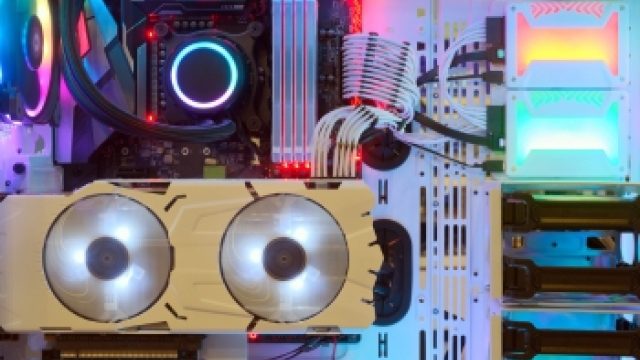In the realm of PC cooling solutions, the ongoing debate between the 280 vs 360 AIOs has captured the attention of tech enthusiasts and gamers alike.
Like knights of old wielding mighty swords, these All-In-One liquid cooling systems compete for supremacy in the quest to keep our prized processors frosty.
Let’s embark on a journey to decipher this contest, analyzing the cooling power, performance, size considerations, and much more.
Cooling Power: 280 vs 360
The clash commences with a spotlight on cooling prowess. Both the 280mm and 360mm AIOs exhibit their strengths.
The numbers here – 280 and 360 – signify the radiator’s length in millimeters, a crucial factor governing cooling capability. The larger the radiator, the greater the heat dissipation potential.
However, it’s not merely about raw size; factors like fan efficiency and pump performance choreograph this thermal ballet.
Size Matters in Cooling
Picture a gladiator in an arena – the bigger, more formidable contender often holds an advantage. In the realm of AIO cooling, size indeed matters.
A 360 AIO boasts a more expansive radiator, accommodating three fans in harmony.
This assembly generates a grand symphony of airflow, escorting heat away from the processor. Meanwhile, the 280 AIO settles for a slightly smaller stance, though its performance remains noteworthy.
Performance Check: 280 vs 360
But does bigger always translate to better performance? The battle reaches a boiling point when the performance metrics are dissected.
The 360 AIO flexes its muscles in scenarios where intense heat battles occur, such as during CPU-intensive tasks and overclocking endeavors.
Yet, the 280 AIO doesn’t bow down easily, displaying remarkable competence in maintaining acceptable temperatures even under demanding circumstances.
Related Article: Best Pre Built Office PC: Elevate Your Productivity
AIO Showdown: 280 or 360?
Imagine this conflict as a showdown in the wild west of PC components. The 280 AIO, akin to a sharpshooter, focuses its resources for precise cooling.
On the other hand, the 360 AIO spreads its influence across a larger territory, akin to a vigilant marshal overseeing an entire town. As PC builders, it’s our prerogative to choose the hero that suits our rig’s temperament.
Radiator Size Impact
The tale continues with a deep dive into the impact of radiator size. A larger radiator not only dissipates heat more effectively but also does so with a touch of elegance.
Smaller radiators might wrestle when dealing with an overclocked CPU, whereas their bigger brethren exhibit a calm and confident demeanor, keeping temperatures within acceptable bounds.
Temps Compared: 280 vs 360
As we tread this heated battleground, numbers paint a vivid picture. In the coliseum of stress tests, the 280 AIO demonstrates admirable resistance, keeping the processor’s temperature within a bearable range.
However, the 360 AIO stands tall, confidently showcasing its prowess by maintaining even lower temperatures. The margin might not be vast, but in the world of hardware, every degree counts.
Choosing Wisely: AIO Size
How does one make a wise choice amid this flurry of cooling solutions? The answer lies in understanding one’s PC usage.
For the everyday user, content creator, or casual gamer, the 280 AIO might present an excellent balance between performance and cost.
In contrast, the 360 AIO becomes the go-to savior for the power users, avid overclockers, and those who revel in pushing their system’s limits.
Related Article: What is The Average Life of a Cooler? Exploring Lifespan
Gaming Rig Cooling: 280 vs 360
The battle expands to encompass the virtual battlegrounds where gamers wage war. AIO cooling is not just about preserving the silicon heart but enhancing the gaming experience.
A cooler CPU means the system can divert more attention to rendering breathtaking landscapes, orchestrating explosions, and ensuring a lag-free showdown. Here, both contenders – the 280 and 360 AIOs – contribute their share, albeit with varying intensities.
Overclocking with AIOs
Ah, overclocking – the practice of squeezing every ounce of performance from your hardware. This venture necessitates a robust cooling solution, and the 360 AIO beckons like a mentor guiding you through this ambitious journey.
It handles the elevated temperatures that come with overclocking with a firm grip, ensuring your dreams of unprecedented processing power don’t melt away.
Form Factor Consideration
Beyond performance, we delve into the aesthetics and form factor. The 280 AIO, with its sleek form and nimble size, slides into cases with ease, accommodating various setups.
The 360 AIO, while grand, might require a case with ample room, restricting its compatibility somewhat. Thus, the battle’s arena expands to our PC chassis – a realm of choices and constraints.
Noise Levels: 280 vs 360
In the symphony of PC operation, the noise emitted becomes a crucial note. The 280 AIO, with fewer fans, often maintains a more serene environment.
The 360 AIO, while offering exceptional cooling, might contribute a tad more to the chorus. But fear not, for advancements in fan technology have silenced the chatter considerably, allowing us to strike a balance between cooling and tranquility.
Benchmarks: AIO Radiator Size
Let’s venture into the realm of benchmarks, where numbers reign supreme. The 280 vs 360 AIO bout is a recurring theme, a drama played out in countless tests.
In synthetic benchmarks, the 360 AIO flaunts its superiority, boasting lower temperatures and allowing the CPU to stretch its legs further. But remember, real-world scenarios often blur these disparities, making the choice less stark.
Customization and Looks
PC building is an art, and aesthetics are its strokes of creativity. The 280 and 360 AIOs not only cool but contribute to the visual symphony within your case.
The 280 AIO might embrace a minimalist approach, while the 360 AIO presents a canvas of grandeur. RGB lighting, unique tubing layouts – these elements enhance not only cooling but the visual narrative of your rig.
Cooling Efficiency Faceoff
As the dust settles, let’s reflect on the cooling efficiency faceoff. The 280 vs 360 AIO saga proves that both contenders are stalwarts in the cooling arena.
Each dances to a different tune – the 280 AIO excelling in balance, the 360 AIO delivering sheer force. It’s akin to choosing between a nimble sports car and a robust SUV; your preference shapes your journey.
Price to Performance: AIOs
The curtain falls on our exploration, and it’s time to talk finances. The 280 vs 360 AIO conflict also touches upon the price-to-performance ratio.
The 280 AIO often emerges as the budget-friendly victor, catering to those who seek capable cooling without breaking the bank. In contrast, the 360 AIO commands a slightly higher cost, justifying it with its performance-driven approach.
FAQs About 280 vs 360 AIO
Is 280mm AIO better than 360?
A 280mm AIO offers good cooling performance for most CPUs.
However, a 360mm AIO generally provides better cooling potential, especially for overclocking and high-end CPUs.
Is 280mm AIO worth it?
A 280mm AIO can be worth it if you want efficient cooling without the bulk of a 360mm radiator. Consider your CPU’s needs and your case’s compatibility for the best decision.
Do I need a 240 or 360 AIO?
The choice depends on your CPU and cooling requirements.
A 360 AIO offers superior heat dissipation, suitable for high-performance setups, while a 240 AIO is sufficient for moderate usage.
Do I need a 360 AIO for 5900X?
For a CPU like the 5900X, a 360 AIO is recommended, as it helps manage the higher thermal output, ensuring optimal performance and longevity.
Can a 360 AIO fit in a mid tower?
Many mid towers support 360mm AIOs. Check your case’s specifications to ensure compatibility, as some smaller mid towers might have restrictions.
Is a bigger AIO radiator better?
A larger radiator allows for more surface area, which can enhance cooling efficiency.
However, factors like fan quality and pump performance also contribute to overall effectiveness.
Is a 360mm AIO overkill?
A 360mm AIO might be overkill for CPUs with lower heat output.
It’s best suited for high-performance processors and those who plan to overclock intensively.
How long does a 360 AIO last?
A well-maintained 360 AIO can last around 5 to 6 years on average.
However, longevity varies based on usage, manufacturing quality, and proper care.
What are the cons of AIO cooler?
AIO coolers can be more expensive than air coolers, and there’s a slight risk of leaks.
They also have limited upgrade options compared to custom water cooling loops.
Is a 280mm radiator enough for a 12900k?
While a 280mm radiator can handle the thermal demands of a 12900K, a 360mm radiator would provide even better cooling performance, especially during heavy workloads or overclocking.
Final Thoughts About 280 vs 360 AIO
In the realm of PC cooling, the 280 vs 360 AIO battle boils down to a choice between finesse and force. The 280 AIO offers a balanced approach, ideal for everyday users seeking reliable performance without draining their wallets.
On the other hand, the 360 AIO stands tall as a performance-driven champion, best suited for enthusiasts who demand the utmost power for intense tasks and overclocking feats.
Whether you favor elegance or brute strength, the choice between these cooling titans ultimately hinges on your system’s aspirations.
With both contenders showcasing impressive feats, the victor emerges as the one that aligns with your ambitions.


